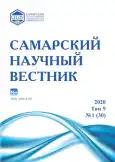Курганы Самарской области в фокусе спутниковых снимков
- Авторы: Вальков Д.В.1
-
Учреждения:
- Научно-производственный центр «Универсальные технологии и разработки»
- Выпуск: Том 9, № 1 (2020)
- Страницы: 146-159
- Раздел: Исторические науки и археология
- URL: https://journals.rcsi.science/2309-4370/article/view/34551
- DOI: https://doi.org/10.17816/snv202091204
- ID: 34551
Цитировать
Полный текст
Аннотация
Статья сфокусирована на двух археологических проблемах: корректность системы учета памятников археологии и эффективность их обнаружения, особенно в зонах предстоящих строительных работ. Актуальность проблем раскрыта автором на примере истории исследования курганного могильника «Самарский (Просвет) I» и на примере обследования его территории методом анализа разнородных данных дистанционного зондирования Земли (ДЗЗ). Установлено, что за период 1973-2016 гг. памятник обследовали не менее 8 экспедиций. За это же время накопившиеся ошибки в описании привели к тому, что в системе учета объектов археологического наследия Самарской области этот памятник под одним названием зафиксирован под двумя номерами и в двух административных районах. На территории памятника автор сформировал набор данных ДЗЗ, включающий архивные и современные космические снимки. Затем все эти данные и местоположения курганов, выявленных предшествующими исследователями, в специализированном программном продукте приведены к единой проекции. По разным данным ДЗЗ, выделяется от 31 до 180 зон характерной контрастной пикселизации. Местоположения всех курганов, ранее выявленных в поле, совпадают с ними. Следовательно, многие из этих зон также могут быть полностью распаханными курганами, сохранности которых угрожает строительство нефтепроводов по соседству. По этой методике произведена проверка территории еще четырех курганных могильников, обследованных в 2015-2017 гг. и расположенных в зонах строительства. На них обнаружены курганы, не выявленные исследователями ранее и, соответственно, поврежденные в ходе строительных работ. Выводы: полевому археологическому обследованию должен предшествовать анализ разнородных данных ДЗЗ; наиболее надежным методом является исследование курганных могильников раскопом сплошной площадью, накрывающим и межкурганное пространство. Однако этот же метод, как наиболее затратный, требует корректировки по данным ДЗЗ и иными, не инвазивными методами.
Ключевые слова
Полный текст
Открыть статью на сайте журналаОб авторах
Денис Владимирович Вальков
Научно-производственный центр «Универсальные технологии и разработки»
Автор, ответственный за переписку.
Email: valkovd@mail.ru
начальник отдела археологических исследований
Россия, СамараСписок литературы
- Кузьминых С.В., Сафонов И.Е., Сташенков Д.А. Вера Владимировна Гольмстен: Материалы к биографии. Самара: ООО «Офорт», 2007. 168 с.
- Гольмстен В.В. Дневник Восточной экспедиции. 1921 г. // Архив ИИМК РАН. Ф. 44. Д. 3.
- Гошко Т.Ю., Агапов С.А., Отрощенко В.В. Металеві казани з Великого Степу за доби пізньої бронзи. Київ: IА НАН України, 2018. 328 с.
- Вальков Д.В., Большакова Н.В., Кошутин Р.А. Опыт верификации памятников археологии, открытых экспедициями Общества археологии, истории и зтнографии методами анализа геопространственных данных. На примере «курганника у с. Домашка» (в печати).
- Камаев В.В. Отчет об археологических разведках по р. Самаре в Куйбышевской области по открытому листу № 388. Куйбышев, 1976 // Архив ИА АН СССР. Р-1. № 5800.
- Кочкина А.Ф. Отчет о раскопках I Красносюндюковского городища в Ульяновском районе Ульяновской области и разведках в Волжском районе Самарской области в 1991 году. Самара, 1991 // Архив ИА РАН. Р-1. № 16845.
- Колев Ю.И., Кузьмина О.В., Сташенков Д.А., Турецкий М.А. Курганный могильник Просвет I в Волжском районе Самарской области // Бронзовый век. Эпоха героев (по материалам погребальных памятников Самарской области). Самара: АНО «Издательство СНЦ», 2012. С. 248-295.
- Кондратьев С.А. Отчет о результатах проведения разведочных археологических исследований на территории муниципального района Кинельский Самарской области в 2012 году по Открытому листу № 1077. Самара, 2013 // Архив ИА РАН. Р-1. № 34717.
- Дрёмов И.И. Отчет об археологическом обследовании участков реконструкции магистрального нефтепровода в Клявлинском, Исаклинском, Сергиевском, Кинельском, Волжском районах Самарской области в 2016 г. Саратов, 2016 // Архив ИА РАН. Р-1. № 51193.
- Перечень выявленных объектов археологического наследия Самарской области [Электронный ресурс] // Управление государственной охраны объектов культурного наследия Самарской области. - http://nasledie.samregion.ru.
- Архив Историко-эко-культурной ассоциации «Поволжье».
- Вальков Д.В. Интеграция данных ДЗЗ и анализ микрорельефа - опыт развития методики полевого археологического исследования // Самарский край в истории России: мат-лы межрегион. науч. конф., посв. 165-летию со дня основания Самарской губернии и 130-летию со дня основания СОИКМ им. П.В. Алабина. Вып. 6. Самара: АНО «Издательство СНЦ», 2017. С. 231-241.
- Бойцов И.А. Отчет об итогах натурного полевого обследования земельного участка, отводимого под проектирование и строительство волоконно-оптической линии связи на объекте - «Автодорожные телекоммуникационные сети в обочине автомобильной дороги общего пользования федерального значения М5 «Урал» в границах Сергиевского, Красноярского и Волжского районов и г.о. Самара, Самарской области в 2016 году. Самара - Москва, 2017 // Архив ИА РАН. Р-1.
- Костин Н.В. Отчет о проведении раскопок кургана № 25 курганного могильника «Конезавод II» на территории муниципального района Красноярский Самарской области (по открытому листу № 2185 в 2017 году). Самара, 2018 // Архив ИА РАН. Р-1.
- Васильева И.Н., Кулакова Л.С., Салугина Н.П., Рослякова Н.В. Раскопки курганного могильника позднего бронзового века Садгород IV // Самарский край в истории России: мат-лы межрегион. науч. конф., посв. 165-летию со дня основания Самарской губернии и 130-летию со дня основания СОИКМ им. П.В. Алабина. Вып. 6. Самара: АНО «Издательство СНЦ», 2017. С. 172-196.
- Цибин В.А., Горбунов Н.А., Кормилицын Д.В., Мясников М.О., Шигаев В.Н., Прохорова К.Д. Охранно-спасательные археологические раскопки в Безенчукском районе // Археологические открытия в Самарской области 2017 года. Самара: АНО «Издательство СНЦ», 2018.
- Об утверждении границ территорий выявленных объектов археологического наследия, включённых в перечень выявленных объектов культурного наследия Самарской области: приказ УГООКН Самарской области от 16.01.2018 г. № 2 [Электронный ресурс] // Управление государственной охраны объектов культурного наследия Самарской области. - http://nasledie.samregion.ru/sites/nasledie.samregion.ru/files/docs/2.pdf.
Дополнительные файлы


















